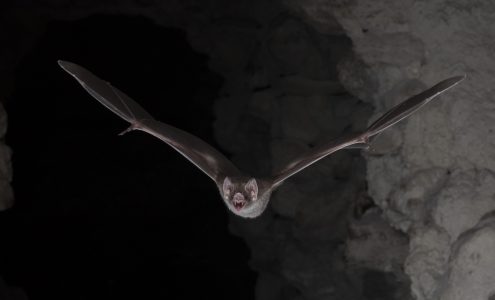New research from CGG: Vampire bats, genetics and microbes
Researchers from the Center for GeoGenetics have studied vampire bats with a hologenomic approach, looking at the relationship between the animal’s genes and microbiota. This holistic approach is part of a new era in genetic research.

New research from the DNRF’s Center for GeoGenetics (CGG) studies vampire bats and tries to identify the relationship between the animal’s genes and microbiota – microorganisms living in symbiosis with the host animal. Professor Tom Gilbert of CGG and Lisandra Zepeda Mendoza, a former Ph.D. student at the center, are behind the research, which was published in the recognized scientific journal Nature Ecology & Evolution at the end of February.
According to Professor Gilbert, they chose to focus on this specific animal for several interesting reasons. For example, the three species of vampire bats that exist today are the only mammalians that exclusively feed off blood.
“Blood is really a very bad source of food for mammals because it contains too much salt and protein and not enough vitamins and minerals. So, we were interested in how and why vampire bats are the only vertebrates that have evolved to live off this bizarre diet,” explained Gilbert.
Therefore, the researchers sequenced the genome and gut microbes in vampire bats and compared it with the genome and microbes in other bat species. The research clearly shows that a diet so unusual demands evolutionary adaptation in both the genome and the microbiota of the animal.
You can read more about what the study showed at videnskab.dk here (in Danish)
Professor Gilbert noted that the most interesting thing about the research project is not the study of vampire bats per se, but the so-called hologenomic approach used in the research.
“In the past, researchers would either look at the microbes of the host animal or at the genome, but now we are more interested in the relationship between the two. Today, I use this holistic approach in practically all my research and this research exemplifies the hologenomic approach, where we focus on both the genetics and the microbes of an organism, and finally how the two parts interact and contribute to each other,” said Professor Gilbert.
For instance, he and his colleagues are using the same approach in a research project about the fermentation process in wine production and in another project about salmon farming.
“In our research about salmon farming, one of the things we look at is how the salmon genes and microbes contribute to the size and health of the fish. So even though all these research projects are very different from the outside, the hologenomic approach can be applied to basically everything in the field of genetic research,” explained Gilbert. “And this research of vampire bats is a very good example of the possibilities of hologenomics.”
The scientific article from Nature Ecology & Evolution is available here.
